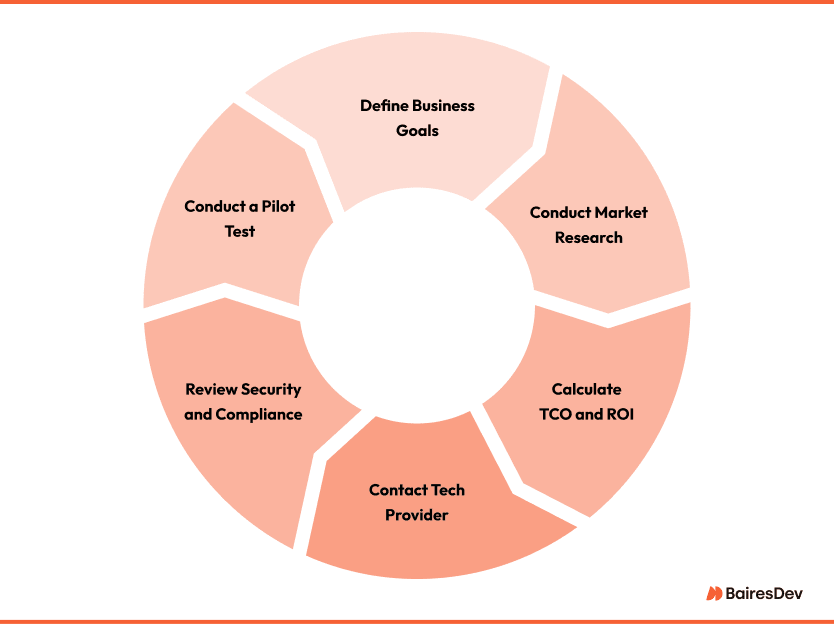Having a comprehensive tech stack is more important than ever if companies want to be efficient, reliable and profitable. PwC’s recent report on the UK’s manufacturing industry found that today’s leaders are all striving for productivity, and many are now relying on continued tech adoption to achieve it.
It’s the same story across countries and industries; tech investment is now a fundamental part of C-suite decision-making, across both enterprises and SME organizations. In today’s landscape, many companies are turning to staff augmentation as a strategic solution to scale their teams quickly, bringing in specialized expertise when needed, without the long-term commitment of hiring full-time employees. But how can senior executives make sure they’re making the right investment in technology for their company?
We’ve outlined the 6 factors that you need to consider when making any new investment in technology. We’ll also detail how to align each of these factors with your specific business goals, alongside practical advice that can improve your investment plans in the future.
Investment in Technology Requirements: 6 Improvements or Features New Tech Should Offer Your Company

These are the 6 key factors that you should consider any time you’re looking to invest in new tech, based on what they should be offering your company and how they’re implemented:
1. Improve your Existing Processes
Any investment in technology should improve processes you already have in place. It should make production faster if you’re a manufacturing company, for example, or make your customer service process more efficient. For some technologies, the main improvement might be to reduce costs.
When reviewing any new tech, first look at how exactly it’s going to improve operations. Quantify this improvement, as this will help you determine the financial benefit of your tech investment further down the line.
2. Meet your Unique Business Needs and/or Goals
Technology investments also need to fit in with the specific needs of your company. It’s worth defining what these needs before you start making an investment in technology; we’ve gone into more detail on how to do this below.
Once you have your clearly defined business goals, any tech you choose must be designed to achieve them.
3. Be Easy to Use and Integrate
Even if a new solution improves your operations and meets your goals, it still needs to be usable. You must consider how long it takes for an investment in technology to fully integrate within your company.
For some software, it’s as simple as signing up and training a couple of staff members. But some companywide database changes or more extreme examples of disruptive technologies can take months, if not years, of data transferral. These implementations require businesswide training programs and other significant process changes before they start working. Sometimes the improvements this tech offers might be worth the integration time, but you should always factor this in before you decide to adopt.
4. Fit In With Your Budget
Tech budgets are already high and continue to increase. To remain profitable, decision-makers have to keep their budget contained when making any investment in technology. They should know how any tech, whether it’s based on machine learning, cloud computing or something else entirely, impacts revenues.
New solutions should fit within a pre-defined budget, and the cost of other factors like implementation and ongoing maintenance also needs to be considered.
5. Provide Scalability
New technologies need to scale alongside your business, otherwise, they risk being useless in a few years. Any tech you adopt should have a clear scaling plan for new seats, features or integrations based on how you anticipate your company will grow.
You should know how this scaling development functions, and have a clear idea of how these scaled advancements will result in improved efficiencies for your company.
6. Offer Reliability and Security
Finally, new tech needs to work reliably and must be secure. Integrating any new technology that isn’t secure during digital transformation can compromise your entire tech stack and your company’s sensitive data. Focus on understanding what security measures new technology has in place before you choose to adopt it.
Methodology for Investment in Technology Decision-making
Bearing these 6 factors in mind, we’ve outlined a methodology that should be followed before you adopt any new technologies. Note that this is an approximate process and should be tailored to meet the specific needs of your company.

Each of these stages roughly corresponds to one of the factors above. However, here they’re ordered in a clear process that you can follow when investing in technology.
1. Define Business Goals and Identify Problems
The first step to any successful investment in technology is determining where any technology can potentially support your company. If you don’t already have a business plan or an overarching strategic document, create one to outline your key business objectives.
Once you have these objectives, identify current problems in your operations that are hampering your development. These are the problems you’ll need your technology investment to solve.
Find the problem that’s causing you the most issues at the moment, and focus on finding a technology that can solve it.
2. Conduct Competitive Analysis and Market Research
Next, review your competitors and see if you can determine any tech investments they’ve made that you’re lacking. This can be a simplified way of identifying sector-wide advancements that could benefit your business.
Further market research may also uncover these opportunities. By aligning these potential tech choices with your business goals, you should be able to create a list of technologies to consider.
3. Review Tech Financially by Calculating TCO and ROI
The two most reliable calculations for considering the cost of technology investment are TCO and ROI. TCO refers to the total cost of ownership, which factors in variables like training time, integration time and maintenance. ROI, return on investment, calculates the potential return of an investment in technology based on the cost and your expected revenues or cost savings.
By calculating and cross-checking each of these amounts you can determine whether an investment in technology fits within your current budget.
4. Contact a Tech Provider to Discuss Integration, Compatability and Scalability
By now you should have a shortlist of technologies that meet your business needs, fit your budget and which will improve your processes. At this stage, you should contact tech providers, along with your internal IT team, to discuss how their tech is integrated.
This will determine how long the integration process will take and whether the technology is compatible with your current system. Make sure to also discuss whether the tech can scale alongside your plans for business growth.
5. Review Security and Compliance
After these meetings, work with your tech team to determine how secure each proposed technology is. It’s critical that you also factor this information against any regulations you need to follow in your particular industry. Assess whether these technologies meet your regulatory needs, identify any risks involved, and request security tests if necessary.
6. Conduct a Pilot Test
The final and arguably most important method for effectively investing in technology is to always conduct a pilot test. These can be costly, so at this stage you should have determined only one or two possible technologies to adopt.
A pilot test reviews how efficient, secure, compatible, and reliable your chosen technology is within your current system. It also reveals any risks before you fully implement it. It’s essential to make sure you’ve made the right decision on your chosen technology.
Find the Right Investment in Technology Approach for Your Company
Making an investment in technology is always a significant decision that shouldn’t be taken lightly. By considering these factors and following the above methodology, you can ensure that the solutions you source align with your specific business needs. These solutions will also provide future-proof scalability and efficiencies that can support your business for many years to come.







